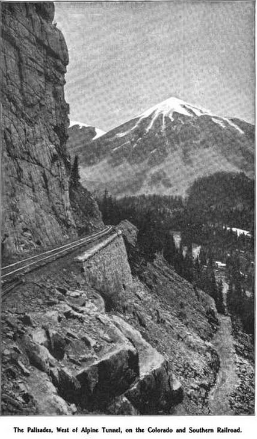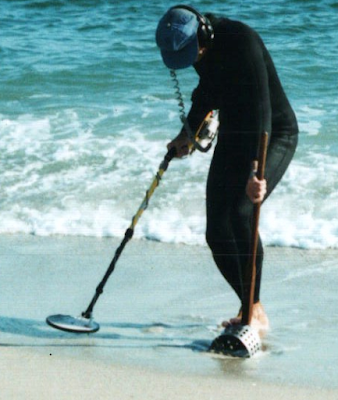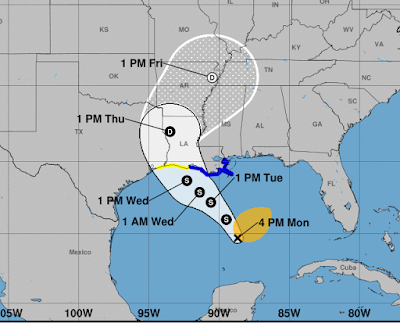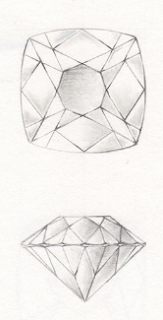Written by the TreasureGuide for the exclusive use of treasurebeachesreport.blogspot.com.
Which is best: listening to the auditory signal from your metal detector or watching a visual display? |
| This Morning Near Low Tide. |
Beach conditions remain basically unchanged.
---
I apologize and resign. I was wrong. I think so anyway.
I went back and read an old post because I noticed that a lot of people were reading it after I referred to it in a more recent post. After reading the old post, I was about to pull my hair out. The post was about the fossil bone with a drilled hole and cut marks. When I referred to that fossil in the old post, I talked like someone found the fossil and drilled and cut it. I don't know why I believed that. It is much more likely that the bone was drilled to obtain the bone marrow when it was fresh. I remember Fred Dengler, my old buddy and fossil expert, telling me that at some point. Why I believed it might have been drilled and cut after it was already fossilized is beyond me. I guess it is remotely possible, but it just doesn't seem likely to me now, especially after remembering what Fred told me.
Maybe I shouldn't take it so hard. You're supposed to live and learn, and if you never change your mind you probably aren't learning anything. That is some consolation. And it is sort of neat to think of having something that somebody cut and drilled maybe thousands of years ago.
---
First I want to make a few things clear. There are a couple important basic concepts. They are the concepts of sensation and perception. I'll use the following definitions. Sensation is input about the physical world registered by your sensory receptors such as the eyes, ears, mouth, nose, and skin. Perception, on the other hand, is the process by which the brain selects, organizes, and interprets sensations; it is often influenced by learning, memory, emotions and expectations. In other words, sensation occurs more in the sensory organs, while perception involves more brain.
The auditory and visual processing systems are very different. The auditory system is a sequential processing system, while the visual system is a parallel processing system. If you know about parallel processors in computers, you'll understand that.
To illustrate, if you are in a large room where a lot of conversations are taking place, you can only really listen to one at a time. If you think you are listening to two conversations, you are probably sampling - taking bits from one then the other and then putting the conversations together from the samples you took from each. That is sequential processing. It is like a single stream of information flowing through one pipe or hole.
Vision involves parallel processing. You can look at the entire room and see hundreds of people at once. A lot of the processing is actually done in the retina before it is sent to the brain. It is not so much like a small stream flowing through a small keyhole. It is more like an entire screen. Not only do you see the forest but also all the trees.
Signals always occur in a field of noise. There is internal and external noise. The sound of the wind and waves would be examples of external noise, and tinnitus, ringing in the ears, is an example of internal noise. You can also be distracted by various irrelevant sights and sounds.
Two of the most basic characteristics of sound is intensity, or loudness, and frequency, or pitch. When you listen to a metal detector signal, you will mostly be listening for a change in loudness and tone. The detector, of course, produces some noise. depending upon how well it is set up and how well you are using it.
When you watch a graphic display or meter, there can be a variety of types information displayed, most often including things like some indicator of target depth and the type of target.
Most people will probably get more useful information from detectors that provide visual displays. Some of the information can incorrect or misleading, but it will provide a good bit of useful information.
If I had a simple answer to the question I posed, I'd say that most people will probably find the visual information useful. Visual displays can provide a lot of information. Theoretically they can provide all the information of an auditory signal and more. Although some submersible systems provide a light to indicate a signal, all of the major metal detectors provide an auditory signal.
The detector can do a lot of the processing for you and a visual display can provide a lot of really good information in an easy and meaningful form.
An auditory signal can also provide a lot of good information besides indicating if a target is present or not. I like reading ground effects. You can do that if you don't balance or set up your detector to eliminate all ground signals.
I do want to say, however, that some people can learn to extract a lot of information from an auditory signal - perhaps much more than you might think, but it does require both a keen aptitude and a lot of experience.
In the end, the user still has to make good decisions. No metal detector can make the most important decision for you. It will not tell you where to put your coil. If you don't put your coil over good targets, none of that other information matters. A lot of the information for that important decision will come from visually scanning the landscape and referring to your acquired knowledge base.
---
Happy hunting,
TreasureGuide@comcast.net








































